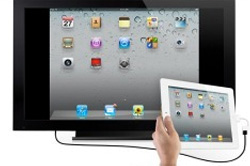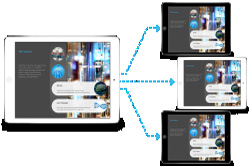Got an iPad? Are you using it for client presentations? You should be. New technology is exciting, but with it comes the awkward business of figuring out just what’s “appropriate” – especially with a very personal device like a tablet. So, we’re really glad that Kim Feld sent this article to share with DTG readers!
![]() Got an iPad? Are you using it for client presentations? You should be. New technology is exciting, but with it comes the awkward business of figuring out just what’s “appropriate” – especially with a very personal device like a tablet. So, we’re really glad that Kim Feld sent this article to share with DTG readers!
Got an iPad? Are you using it for client presentations? You should be. New technology is exciting, but with it comes the awkward business of figuring out just what’s “appropriate” – especially with a very personal device like a tablet. So, we’re really glad that Kim Feld sent this article to share with DTG readers!
Kim Feld is VP of Customer Affairs for StoryDesk . . . she writes :
Since Miss Manners doesn’t really cover outside sales, we thought we’d offer a primer on iPad etiquette for those struggling to feel comfortable using the device in meetings. New technology is exciting, but with it comes the awkward business of figuring out just what’s “appropriate” – especially with a very personal device like a tablet. For this reason, we’ve put together a light-hearted primer on what seems to work, and what doesn’t, when it comes to the interpersonal mechanics of iPad presentations.
There are a number of ways to present to prospects/clients using iPad. Here are some of our favorites, along with the recommended do’s and don’ts of each approach.
 The “Side by Side”
The “Side by Side”
The side-by-side is ideal for informal 1-on-1 meetings, at tradeshows or in the field. In many ways, it’s the best use of iPad in a presentation setting as it lets you stand shoulder-to-shoulder with the client and go through the presentation together. Use this approach when you want to answer quick questions, demonstrate capability or competency, or problem solve.
Do:
- let the client hold the device; get close without getting uncomfortable (you shouldn’t be able to smell their breath);
- hold the device arm’s length between you and the prospect;
- set it on a table while you sit next to each other, shoulder to shoulder.
Don’t:
- stand directly opposite the client;
- be afraid to turn your head and make eye contact;
- use an iPad mini in these situations – full size iPads are better suited to this type of interaction;
- treat the iPad delicately – it’s a tool, and they don’t break easily.
The Pass Back-and-Forth
Most pre-arranged (not impromptu) meetings take place in a conference room where there is a healthy distance between you and the prospect. It’s a formal setting but that doesn’t necessarily mean the meeting itself needs to be terribly formal. A friendly manner and a focus on conversation – not a slide deck – go a long way toward breaking down the barriers of interaction. Use the iPad presentation to support the conversation, not lead it.
Do:
- have a conversation without opening up the pitch for a while – this is your chance to connect and understand the prospect’s pain-points;
- use the iPad presentation to support the conversation, not lead it;
- push the device across the table when you need content to establish competence or credibility;
- pull the device back once an objection has been addressed and you’re moving on to the next topic.
Don’t:
- use the iPad presentation as a crutch – it’s a toolkit, so pull out the tool you need for a specific job;
- let the client hold on to the device after you’ve made a point;
- forget to take the device with you when you leave(!).
The Big Screen
Displaying an iPad on the big screen (projector or TV) is suprisingly easy and actually quite an effective way to present. You’ll need either this or this Apple adaptor to connect newer model iPads (those with the small “Lightning” port) to a monitor or projector. In our experience, it just works. No fiddling around with screen resolutions or correct fonts. The iPad displays beautifully.
Do:
- make sure you have the right adaptor for the right iPad for the right monitor/TV;
- remember to plug in and test audio before presenting;
- try to avoid the typical slideshow experience – the iPad is a non-linear device, and so your audience is expecting something more than just another Powerpoint;
- turn off the device periodically and focus the conversation on you rather than the blue glow;
- stand near the cable connecting your device to the screen – it can come unplugged pretty easily.
Don’t:
- fiddle around with other apps while the iPad is displaying;
- get carried away swiping and tapping through the content – it’s hard for audiences to follow touch interactions on a big screen;
- pass the device around.

The Roundtable™
Roundtable, which is a feature of ShowPad, enables guided, group iPad presentations. A presenter can broadcast her presentation to up to 10,000 devices. Participants can follow along on their iPads, interacting with the content. But only the presenter can advance the screens – ensuring group focus.
Do:
- make sure all iPads have access to an active internet connection – either through the house Wi-Fi or through a hotspot;
- consider bringing iPads (minis are great) for your audience;
- prepare your content for individual interactions – not all content (videos, for example) are ideal for individual control
.
Don’t:
- leave anyone out; even if they’re not in the room, they can still participate so long as they have an iPad;
- forget to pause for comments and feedback throughout the presentation;
- improvise. Practice delivering your pitch via Roundtable as the dynamic and flow is different when individuals have equal access to the information as it’s being delivered.
Above, we’ve presented several ways to present to prospects/clients using iPad. Always remember though — the content is more important than delivery! Make your content interesting, informative and above all, visually exciting!
Kim Feld,
VP of Customer Affairs for ShowPad
![]() Take a demonstration of Showpad
Take a demonstration of Showpad
THANK YOU, Kim!
Don’t forget … we encourage you to share your discoveries with other readers: ![]()
![]()
![]()
![]()
![]()
![]()
![]()
![]()
![]()
![]()
![]()
![]()
![]()
![]()
![]()
![]()
![]()
![]()
![]()
![]()
![]()
![]()
![]()
![]()
![]()
![]()
![]()
![]()
![]()
![]()
![]()
![]()
![]()
![]()
![]()